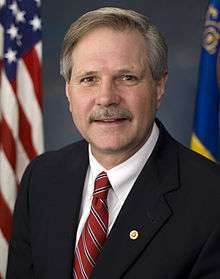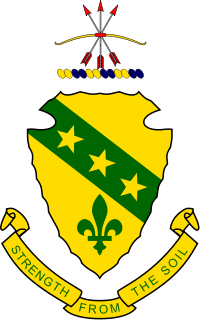John Hoeven
| John Hoeven | |
|---|---|
 | |
| United States Senator from North Dakota | |
|
Assumed office January 3, 2011 Serving with Heidi Heitkamp | |
| Preceded by | Byron Dorgan |
| 31st Governor of North Dakota | |
|
In office December 15, 2000 – December 7, 2010 | |
| Lieutenant | Jack Dalrymple |
| Preceded by | Ed Schafer |
| Succeeded by | Jack Dalrymple |
| Personal details | |
| Born |
John Henry Hoeven III March 13, 1957 Bismarck, North Dakota, U.S. |
| Political party |
Independent (Before 1996) Democratic (1996–1998) Republican (1998–present) |
| Spouse(s) | Mikey Hoeven |
| Education |
Dartmouth College (BA) Northwestern University (MBA) |
| Signature |
|
| Website | Senate website |
John Henry Hoeven III (born March 13, 1957) is the senior United States Senator from North Dakota, in office since 2011. A member of the North Dakota Republican Party, he previously served as the 31st Governor of North Dakota from December 2000 to December 2010. Hoeven was elected to the U.S. Senate in the November 2, 2010 general election. He replaced junior Senator Byron L. Dorgan, who chose not to seek re-election. Hoeven became the senior Senator in 2013 after Kent Conrad retired and was replaced by Heidi Heitkamp, who was once Hoeven's opponent for the Governor's office.
Prior to his election to the Governor's office, Hoeven served as the president of the nation's only state-owned bank, the Bank of North Dakota, from 1993 to 2000.
Early life
Hoeven was born in Bismarck, North Dakota, the son of Patricia "Trish" (née Chapman) and John Henry "Jack" Hoeven, Jr. His ancestry includes Dutch, Swedish, and English.[1] He attended Dartmouth College, where he belonged to the Alpha Chi Alpha Fraternity and graduated with honors. He then earned an MBA from the Kellogg School of Management at Northwestern University, and was a banker in Minot, North Dakota prior to pursuing a political career. From 1993 to 2000, he was the president and CEO of the state-owned Bank of North Dakota.
North Dakota Governor
2000
He sought the office of the Governor of North Dakota as a Republican in 2000, and he was elected, defeating Democrat Heidi Heitkamp by a margin of 55 to 45 percent.
2004
In 2004, when up for re-election, Hoeven faced Democratic challenger Joe Satrom. Hoeven won re-election by a wide margin of 71 to 28 percent.
2008
On September 25, 2007, Hoeven's deputy press secretary, Don Larson, announced that he would be taking a leave of absence from his job to manage the governor's re-election campaign. Another Hoeven staff member, Don Canton, said this was not a formal re-election announcement, but one would be coming later in the fall. On November 13, Governor Hoeven made his formal announcement and campaign kickoff with stops in Fargo, Grand Forks, Bismarck and Minot.[2] On November 4, 2008 Hoeven won a resounding victory carrying 74% of the vote over the Democratic opponent Tim Mathern with 24% of the vote. This is the first time in North Dakota's history that any governor has won three four-year terms in office, though the record for serving is still maintained by Gov. Bill Guy who served 12 years.
Tenure
Hoeven's governorship included the expansion and diversification of the state's economy, which led to a 49.5 percent increase in the state's real gross domestic product.[3] Beginning in 2000, he directed the development of a multi-resource energy program for the state with incentives in each energy sector, leading the state in becoming one of the largest energy producing and exporting states in the country. North Dakota has gained nearly 40,000 new jobs since he took office. The state's wages and personal incomes continue to grow faster than the national average. In the past few years, the state led the nation in export growth. In late 2006, the state's reserve rose past $600 million, and now is over $700 million.[4]
As of December 2009, Hoeven was the most popular governor in the nation. His approval rating stood at 87 percent with only 10 percent disapproving.[5] In January 2007, Hoeven became the nation's most senior governor, having been inaugurated on December 15, 2000, as established by the North Dakota Constitution.
In 2004 John Hoeven served as a Chair of the Midwestern Governors Association.
U.S. Senate
2010 election
On January 11, 2010, Hoeven announced he would run in the 2010 North Dakota Senate election for the seat being vacated by Senator Byron Dorgan,[6] Hoeven beat Democratic challenger Tracy Potter 76.08% to 22.17%. making him the first Republican Senator to represent North Dakota since 1987 – 24 years.[7]
Committee assignments
- Committee on Agriculture, Nutrition, and Forestry
- Committee on Appropriations
- Subcommittee on Agriculture, Rural Development, Food and Drug Administration, and Related Agencies
- Subcommittee on Homeland Security (Chairman)
- Subcommittee on Energy and Water Development
- Subcommittee on Interior, Environment, and Related Agencies
- Subcommittee on Military Construction, Veterans Affairs, and Related Agencies
- Committee on Energy and Natural Resources
- Committee on Indian Affairs
Political positions
Hoeven has walked a conservative line as a politician on some issues and a moderate one on others including increasing education funding, ethics reform, compensation for teachers, as well as increased funding on infrastructure. He is pro-life and opposes abortion except for cases of rape, incest, or threat to the mother's life. He opposes government funding for elective abortions in accordance with the Hyde Amendment. He also opposes same-sex marriage. The senator supports decreasing access to parole for offenders and supports second amendment rights. Hoeven voted for reauthorization of the Violence Against Women Act in 2012.[8] He opposed the Employee Free Choice Act, which included a card check provision. He believes that public health care should be provided only to the elderly and children, that drug control policy should be a state and not a federal issue, that alternative fuels are a long-term solution but that increased oil drilling is required in the short term, and that investment tax credits should be provided for farm investment.[9] Hoeven has been a vocal advocate for the Keystone Pipeline, arguing that it has never leaked and that environmental risks have been exaggerated.[10][11] In reality, the Keystone Pipeline has leaked twice, once in 2010 and, after making that argument, again in 2016.[12]
Hoeven briefly identified himself as a member of the Democratic-NPL Party before becoming active in the Republican Party as a District Chair and volunteer.[13]
In 2013, Hoeven voted to pass Border Security, Economic Opportunity, and Immigration Modernization Act of 2013.[14]
Electoral history
| Party | Candidate | Votes | % | |
|---|---|---|---|---|
| Republican | John Hoeven | 159,255 | 55.03 | |
| Democratic-NPL | Heidi Heitkamp | 130,144 | 44.97 | |
| Write-in | 13 | 0.00 | ||
| Total votes | 289,412 | 100.00 | ||
| Party | Candidate | Votes | % | |
|---|---|---|---|---|
| Republican | John Hoeven (inc.) | 220,803 | 71.26 | |
| Democratic-NPL | Joe Satrom | 84,877 | 27.39 | |
| Libertarian | Roland Riemers | 4,193 | 1.35 | |
| Total votes | 309,873 | 100.00 | ||
| Party | Candidate | Votes | % | |
|---|---|---|---|---|
| Republican | John Hoeven (inc.) | 235,009 | 74.44 | |
| Democratic-NPL | Tim Mathern | 74,279 | 23.53 | |
| Independent | DuWayne Hendrickson | 6,404 | 2.03 | |
| Total votes | 315,692 | 100.00 | ||
| Party | Candidate | Votes | % | |
|---|---|---|---|---|
| Republican | John Hoeven | 181,689 | 76.08 | |
| Democratic-NPL | Tracy Potter | 52,955 | 22.17 | |
| Libertarian | Keith Hanson | 3,890 | 1.63 | |
| Total votes | 238,534 | 100.00 | ||
| Party | Candidate | Votes | % | |
|---|---|---|---|---|
| Republican | John Hoeven (inc.) | 267,964 | 78.47 | |
| Democratic-NPL | Eliot Glassheim | 57,976 | 16.98 | |
| Libertarian | Robert Marquette | 10,521 | 3.08 | |
| Independent | James Germalic | 4,661 | 1.36 | |
| Total votes | 341,486 | 100.00 | ||
References
- ↑ "John Henry Hoeven III". RootsWeb. Ancestry.com. Retrieved February 5, 2012.
- ↑ http://hoevengovernor.com/allmedia.asp?mediaID=65&sz=63728
- ↑ "Percent change in real GDP of North Dakota between 2001 and 2008". Wolfram Alpha. Wolfram Alpha LLC. Retrieved February 5, 2012.
- ↑ "Governor John Hoeven". Archived from the original on 2010-04-19.
- ↑ Knepper, Alex (January 7, 2010). "Who Is John Hoeven?". Race 4 2008. Archived from the original on April 1, 2012. Retrieved February 5, 2012.
- ↑ Cillizza, Chris (January 11, 2010). "Republicans get Hoeven in North Dakota". The Washington Post. Retrieved February 5, 2012.
- ↑ Ogden, Eloise (November 3, 2010). "Hoeven is North Dakota's first Republican senator in 24 years". Minot Daily News. Retrieved May 23, 2015.
- ↑ Bendery, Jennifer (April 26, 2012). "Violence Against Women Act Reauthorization Overwhelmingly Passes Senate". Huffington Post.
- ↑ "John Hoeven on the Issues". On The Issues. OnTheIssues.org & the SpeakOut Foundation. Retrieved February 5, 2012.
- ↑ Kupec, Rob (March 5, 2012). "Senator Hoeven working to revive Keystone Pipeline Project". WDAY.
- ↑ Hoeven, John (February 24, 2012). "Why we need the Keystone oil pipeline". CNN.
- ↑ Neuhauser, Alan (April 8, 2016). "Keystone Leak Worse Than Thought". U.S. News & World Report. Retrieved September 8, 2016.
- ↑ Kleefeld, Eric (January 27, 2010). "Flashback: Republican Senate Candidate Hoeven Rejected GOP And Declared Himself A Democrat In 1996". Talking Points Memo. Retrieved February 5, 2012.
- ↑ Roll call vote 168, via Senate.gov
Further reading
- Biography at the Biographical Directory of the United States Congress
- Profile at Project Vote Smart
- Financial information (federal office) at the Federal Election Commission
- Legislation sponsored at The Library of Congress
External links
| Wikimedia Commons has media related to John Hoeven. |
- Senator John Hoeven official U.S. Senate website
- John Hoeven for Senate
- John Hoeven at DMOZ
| Civic offices | ||
|---|---|---|
| Preceded by Joseph Lamb |
President of the Bank of North Dakota 1993–2000 |
Succeeded by Eric Hardmeyer |
| Party political offices | ||
| Preceded by Ed Schafer |
Republican nominee for Governor of North Dakota 2000, 2004, 2008 |
Succeeded by Jack Dalrymple |
| Preceded by Mike Liffrig |
Republican nominee for U.S. Senator from North Dakota (Class 3) 2010, 2016 |
Most recent |
| Political offices | ||
| Preceded by Ed Schafer |
Governor of North Dakota 2000–2010 |
Succeeded by Jack Dalrymple |
| United States Senate | ||
| Preceded by Byron Dorgan |
U.S. Senator (Class 3) from North Dakota 2011–present Served alongside: Kent Conrad, Heidi Heitkamp |
Incumbent |
| United States order of precedence (ceremonial) | ||
| Preceded by Pat Toomey |
United States Senators by seniority 64th |
Succeeded by Marco Rubio |

